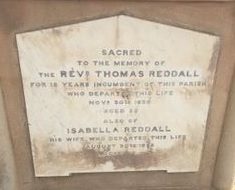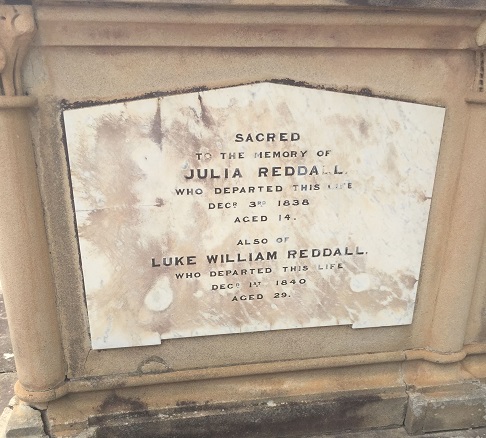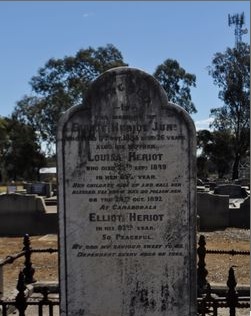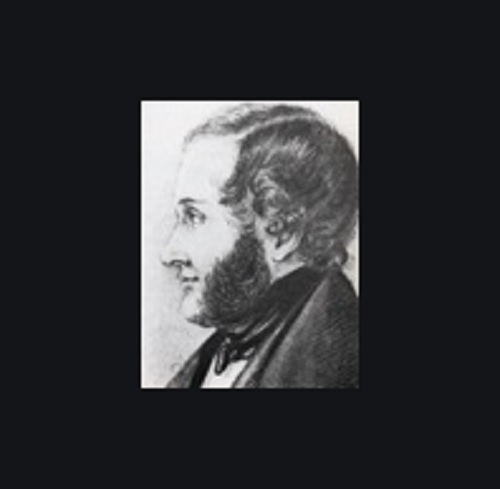Louisa was one of Thomas Mitchell of Mungabareena’s younger sisters.
CA Smithwick in an article for the Border Morning Mail, 21 March 1836, wrote, ‘Herriot said that when they first went to Dora Dora they made their camp on the bank of a creek near its confluence with the Murray and when they asked the blacks the name of the creek the reply was, Durra, durra, durra, durra.’ (3)
They were evidently imitating the noise the water made as it rushed over the rocks and pebbles. Thereafter, the white settlers always referred to it as Durra Durra creek and it was spelt that way on the first official maps but became corrupted into Dora Dora being more English sounding. (3)
Smithwick’s description of Elliot Heriot arriving at Dora Dora suggests it was a new station, ‘when they first went to Dora Dora they made their camp on the bank of a creek’. (3)
There had always been conjecture about what date Elliot Heriot came to Dora Dora because shipping records according to Margaret Carnegie, show Heriot arrived in the colony in 1841 aboard the Nimrod. Yet the above account suggests Herriot was at Dora Dora from as early as 1837.
The Reddall brothers held Dora Dora for little more than a year when an illness took the life of their father, Rev Thomas Reddall who died on 30 November 1838.
The Colonist newspaper of Wed 5th Dec 1838, pg 2, Domestic intelligence wrote;
“Mr Reddall fell a victim to the epidemic that at present rages in almost every part of the colony, or at least that is spreading far and wide. On the forenoon of Wednesday last he celebrated a marriage, apparently in his usual health; and he departed this life on the night of Friday last.”

Just four days later the same illness took the life of Reddall’s daughter, Julia, aged 14. She died on 3rd December 1838. (10)
Then, just two years later tragedy struck again when on 1st December 1840, Luke Reddall drowned at Dora Dora while chasing horses from an island in the middle of the Murray River.
DEATH NOTICE; ‘On the 1st instant, caused by incautiously swimming in the Murray River, LUKE WILLIAM REDDALL, deeply lamented by his family, and all who knew him. The young men of Australia, esteemed him greatly, and the senior members admired his moral line of conduct; he was in his twenty-eighth year.’ (7)

Dora Dora station was in both brothers names (5) however there is no record of John Reddall being at Dora Dora. In 1840, John Reddall, who had been active in trade between Sydney and India went bankrupt and by 1844 was confined in the mental asylum at Tarban Creek, Gladesville. He died aged 47. (8)
CA Smithwick wrote that Herriot got on well with the local indigenous people especially their chief, whom he taught to speak English. After Herriot had been there about a year a lot of strangers joined the little mob that frequented the station. These new fellows started spearing cattle and when told to stop they laid plans to attack the hut and its occupants. (3)
The chief, a Wiradjuri elder, known as King George came to the hut during the night and told Elliot Heriot of the impending raid. (1) (3) (4)
Some accounts say the Blacks were overzealous and sent flaming spears at the out-buildings setting them on fire which gave enough light for the white men to see their attackers and shoot seven or eight. But it seems unlikely the indigenous people would place themselves in such danger.
White accounts mostly portray Indigenous people as ignorant savages but it is important to remember Lady Franklin’s 1839 account of how the Blacks were masters of the bush and able to move about at night without impediment.
So it becomes hard to believe the attacking Blacks would show themselves in the firelight allowing the white men sufficient time to reload and fire muskets which at best were accurate to 50 yards and took approx one minute to re-load.
The reason for the attack is unknown but King George in alerting Herriot of the raid would have made no friends among the Indigenous ringleaders of the attack.
JFH Mitchell wrote that Merriman took part in the raid as did at least one of his brothers and a fellow named Jackendebby. (1)
King George was also friendly with the Mitchells and JFH wrote that the old man took him to a secret initiation when Mitchell was just a boy. Mitchell wrote that King George kept him hidden under his cloak during the secretive ceremony. (1)
We can assume the Wiradjuri man had hopes of educating the boy into indigenous culture.
It is said that shortly before the raid at Dora Dora, two of Spaldings stockmen were speared and killed at Thologolong. (Thologolong means a plain with a creek according to TW Mitchell) (4)
John Spalding was attempting to form a station at Thologolong in 1836 or 1837 when two of his men were killed by indigenous people and they had to remove their stock to the north bank of the river where they formed the Wagra run. (1) (3) (5)
The reason for the killing of the stockmen is unknown but the location may give a clue.
The country they were in was considered sacred to Indigenous people. Bungil is the name of the eagle deity while Wagra is the crow, an equally important creation figure.
Bungil and Wagra sit on either side of the Murray River and both have significant rock formations and rock art.
Spalding then moved to Bungil, the next run to Thologolong and TW Mitchell wrote in the mid-1900s, ‘a hail of spears also drove the Spaldings out of the BungiI Mountains. (4)
So perhaps the reason for the spearing of Spaldings stockmen was ignorance about the importance to Indigenous people of the country they were traversing.
Immediately after Spalding’s men were killed John Jobbins organised a reprisal raid to kill as many Blacks as possible. (3)
At the time of the reprisal killings, Jobbins was said to hold Cumberoona station which had Thomas Mitchell’s Mungabareena run to the west and Dora Dora to the east. If this is accurate then these events occurred before Feb 1839 as JC Bourke, the mailman wrote of visiting Cumberoona in early 1839 and speaking with the owners Charles and Henry Fowler. Bourke also mentioned that John Jobbins had Talgarno station located across the Murray River from Cumberoona. (11)
Jobbins organised a posse who killed men, women and children in what became known as the Dora Dora massacre. (9)
Jobbins and his posse then drove all the Blacks they could find into the hills away from the river sending a clear message they should not return. (4)
Elliot Heriot said he did not believe more than a dozen Blacks were shot as they were too cunning to come into the open and were very clever at concealing themselves. Heriot did not agree with Jobbins actions and refused to take part. However he, nor anyone else made any effort to seek justice for the people killed by Jobbins and his band of murderers. (1)



